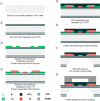Design and characterization of a high resolution microfluidic heat flux sensor with thermal modulation
- PMID: 22163568
- PMCID: PMC3231132
- DOI: 10.3390/s100706594
Design and characterization of a high resolution microfluidic heat flux sensor with thermal modulation
Abstract
A complementary metal-oxide semiconductor-compatible process was used in the design and fabrication of a suspended membrane microfluidic heat flux sensor with a thermopile for the purpose of measuring the heat flow rate. The combination of a thirty-junction gold and nickel thermoelectric sensor with an ultralow noise preamplifier, a low pass filter, and a lock-in amplifier can yield a resolution 20 nW with a sensitivity of 461 V/W. The thermal modulation method is used to eliminate low-frequency noise from the sensor output, and various amounts of fluidic heat were applied to the sensor to investigate its suitability for microfluidic applications. For sensor design and analysis of signal output, a method of modeling and simulating electro-thermal behavior in a microfluidic heat flux sensor with an integrated electronic circuit is presented and validated. The electro-thermal domain model was constructed by using system dynamics, particularly the bond graph. The electro-thermal domain system model in which the thermal and the electrical domains are coupled expresses the heat generation of samples and converts thermal input to electrical output. The proposed electro-thermal domain system model is in good agreement with the measured output voltage response in both the transient and the steady state.
Keywords: electro-thermal domain model; heat flux sensor; microfluidic application; thermopile.
Figures


















Similar articles
-
A suspended membrane nanocalorimeter for ultralow volume bioanalysis.IEEE Trans Nanobioscience. 2002 Mar;1(1):29-36. doi: 10.1109/tnb.2002.806935. IEEE Trans Nanobioscience. 2002. PMID: 16689219
-
A micro-thermoelectric gas sensor for detection of hydrogen and atomic oxygen.Analyst. 2009 Feb;134(2):236-42. doi: 10.1039/b807882c. Epub 2008 Oct 22. Analyst. 2009. PMID: 19173043
-
Structural Design of Dual-Type Thin-Film Thermopiles and Their Heat Flow Sensitivity Performance.Micromachines (Basel). 2023 Jul 20;14(7):1458. doi: 10.3390/mi14071458. Micromachines (Basel). 2023. PMID: 37512769 Free PMC article.
-
Design of pressure-driven microfluidic networks using electric circuit analogy.Lab Chip. 2012 Feb 7;12(3):515-45. doi: 10.1039/c2lc20799k. Epub 2011 Dec 16. Lab Chip. 2012. PMID: 22179505 Review.
-
Droplet-Based Microfluidic Thermal Management Methods for High Performance Electronic Devices.Micromachines (Basel). 2019 Jan 25;10(2):89. doi: 10.3390/mi10020089. Micromachines (Basel). 2019. PMID: 30691049 Free PMC article. Review.
Cited by
-
Acceleration of the Measurement Time of Thermopiles Using Sigma-Delta Control.Sensors (Basel). 2019 Jul 18;19(14):3159. doi: 10.3390/s19143159. Sensors (Basel). 2019. PMID: 31323801 Free PMC article.
-
A Miniaturized 3D Heat Flux Sensor to Characterize Heat Transfer in Regolith of Planets and Small Bodies.Sensors (Basel). 2020 Jul 25;20(15):4135. doi: 10.3390/s20154135. Sensors (Basel). 2020. PMID: 32722361 Free PMC article.
References
-
- Diller TE. Advances in Heat Transfer. Vol. 23. Academic Press; Boston, MA, USA: 1993. Advances in heat flux measurement; pp. 279–368.
-
- Eminoglu S, Sabuncouglu Tezcan D, Yusuf Tanrikulu M, Akin T. Low-cost uncooled infrared detectors in CMOS process. Sensor. Actuator. A-Phys. 2003;109:102–113.
-
- Matsumiya M, Shin W, Izu N, Murayama N. Nano-structured thin-film Pt catalyst for thermoelectric hydrogen gas sensor. Sensor. Actuator. B-Chem. 2003;93:309–315.
-
- Baciocchi M, Bearzotti A, Gentili M, Lucchesini A. Cu/Pd Thin-film thermopile as a temperature and hydrogen sensor. Sensor. Actuator. A-Phys. 1990;22:631–635.
-
- Buchner R, Sosna C, Maiwald M, Benecke W, Lang W. A high-temperature thermopile fabrication process for thermal flow sensors. Sensor Actuator A-Phys. 2006;130–131:262–266.
Publication types
MeSH terms
LinkOut - more resources
Full Text Sources

